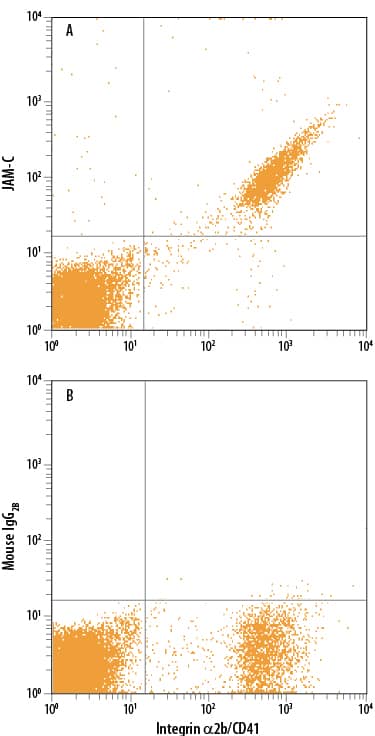Human JAM-C PE-conjugated Antibody
R&D Systems, part of Bio-Techne | Catalog # FAB11891P


Key Product Details
Species Reactivity
Validated:
Cited:
Applications
Validated:
Cited:
Label
Antibody Source
Product Specifications
Immunogen
Val32-Asn241 (Ala149Pro)
Accession # Q9BX67
Specificity
Clonality
Host
Isotype
Scientific Data Images for Human JAM-C PE-conjugated Antibody
Detection of JAM‑C in CD41+Human Platelets by Flow Cytometry.
Human platelets were stained with anti-human CD41 FITC-conjugated antibody and either (A) Mouse Anti-Human JAM-C PE-conjugated Monoclonal Antibody (Catalog # FAB11891P) or (B) Mouse IgG2BPhycoerythrin Isotype Control (Catalog # IC0041P). View our protocol for Staining Membrane-associated Proteins.Applications for Human JAM-C PE-conjugated Antibody
Flow Cytometry
Sample: Human platelets
Formulation, Preparation, and Storage
Purification
Formulation
Shipping
Stability & Storage
- 12 months from date of receipt, 2 to 8 °C as supplied.
Background: JAM-C
The family of juctional adhesion molecules (JAM), comprising at least three members, are type I transmembrane receptors belonging to the immunoglobulin (Ig) superfamily (1, 2). These proteins are localized in the tight junctions between endothelial cells or epithelial cells. Some family members are also found on blood leukocytes and platelets. Human JAM-C cDNA predicts a 310 amino acid (aa) residue precursor protein with a putative 31 aa signal peptide, a 210 aa extracellular region containing two Ig domains, a 23 aa transmembrane domain and a 46 aa cytoplasmic domain containing a PDZ-binding motif and a PKC phosphorylation site (3, 4). Human JAM-C shares 86% aa sequence identity with its mouse homologue. It also shares approximately 36% and 32% aa sequence homology with human JAM-B and JAM-A, respectively (3‑5). Human JAM-C shows widespread tissue expression and the highest levels are found in the placenta, brain, kidney and heart. JAM-C is expressed on endothelial cells of high endothelial venules in human tonsil. It is also expressed on platelets, T-cells and NK cells (3‑5). Unlike other JAM family members, JAM-C forms only weak homotypic interactions. JAM-C binds to JAM-B to facilitate the interactions between JAM-B and the integrin alpha4beta1 (6). This heterotypic interaction between leukocyte JAM-C and endothelial JAM-B may play a role in regulating leukocyte transmigration (5). On platelets, JAM-C is a counter-receptor for the leukocyte integrin Mac-1(CD11b/CD18) (7). JAM-C has also been identified as a strong candidate gene for hypoplastic left heart syndrome (8).
The nomenclature used for the JAM family proteins is confusing. VE-JAM has been referred to in the literature variously as JAM-B or JAM-C. Until further clarification, R&D Systems has adopted the nomenclature where both mouse and human VE-JAM are referred to as JAM-B. Under this system, JAM-C refers to the protein encoded by the gene localized to human chromosome 11.
References
- Chavakis, T. et al. (2003) Thromb. Haemost. 89:13.
- Aurand-Lions, M. et al. (2001) Blood 98:3699.
- Arrate, M.P. et al. (2001) J. Biol. Chem. 276:45826.
- Liang, T. et al. (2002) J. Immunol. 168:1618.
- Johnson-Leger, C. et al. (2002) Blood 100:25793.
- Cunningham, A. et al. (2002) J Biol. Chem. 277:27589.
- Santoso, S. et al. (2002) J. Exp. Med. 196:679.
- Phillips, H.M. et al. (2002) Genomics 79:475.
Long Name
Alternate Names
Gene Symbol
UniProt
Additional JAM-C Products
Product Documents for Human JAM-C PE-conjugated Antibody
Product Specific Notices for Human JAM-C PE-conjugated Antibody
For research use only